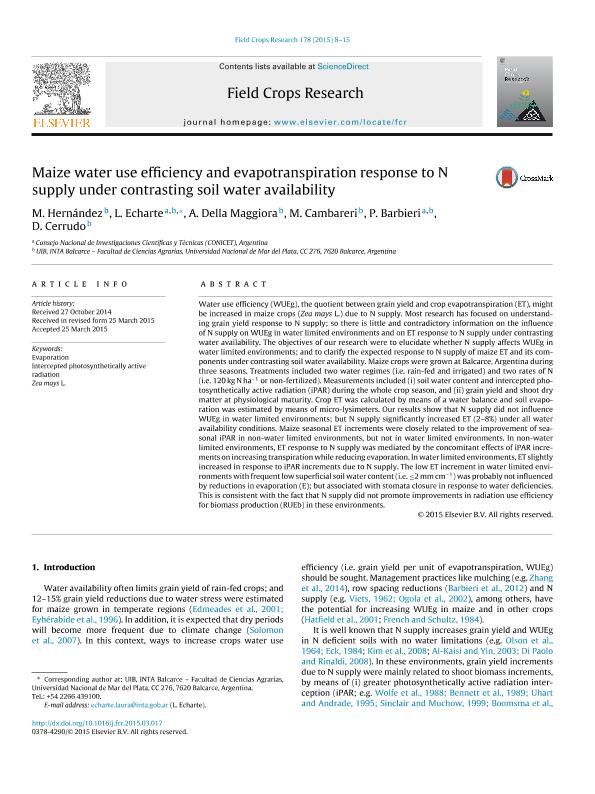Mostrar el registro sencillo del ítem
dc.contributor.author
Hernandez, Mariano Daniel

dc.contributor.author
Echarte, Laura

dc.contributor.author
Della Maggiora, Aída Inés

dc.contributor.author
Cambareri, Matías Alejandro

dc.contributor.author
Barbieri, Pablo Andres

dc.contributor.author
Cerrudo, Diego

dc.date.available
2020-03-25T14:55:50Z
dc.date.issued
2015-07
dc.identifier.citation
Hernandez, Mariano Daniel; Echarte, Laura; Della Maggiora, Aída Inés; Cambareri, Matías Alejandro; Barbieri, Pablo Andres; et al.; Maize water use efficiency and evapotranspiration response to N supply under contrasting soil water availability; Elsevier Science; Field Crops Research; 178; 7-2015; 8-15
dc.identifier.issn
0378-4290
dc.identifier.uri
http://hdl.handle.net/11336/100669
dc.description.abstract
Water use efficiency (WUEg), the quotient between grain yield and crop evapotranspiration (ET), might be increased in maize crops (Zea mays L.) due to N supply. Most research has focused on understanding grain yield response to N supply; so there is little and contradictory information on the influence of N supply on WUEg in water limited environments and on ET response to N supply under contrasting water availability. The objectives of our research were to elucidate whether N supply affects WUEg in water limited environments; and to clarify the expected response to N supply of maize ET and its components under contrasting soil water availability. Maize crops were grown at Balcarce, Argentina during three seasons. Treatments included two water regimes (i.e. rain-fed and irrigated) and two rates of N (i.e. 120kgNha-1 or non-fertilized). Measurements included (i) soil water content and intercepted photosynthetically active radiation (iPAR) during the whole crop season, and (ii) grain yield and shoot dry matter at physiological maturity. Crop ET was calculated by means of a water balance and soil evaporation was estimated by means of micro-lysimeters. Our results show that N supply did not influence WUEg in water limited environments; but N supply significantly increased ET (2-8%) under all water availability conditions. Maize seasonal ET increments were closely related to the improvement of seasonal iPAR in non-water limited environments, but not in water limited environments. In non-water limited environments, ET response to N supply was mediated by the concomitant effects of iPAR increments on increasing transpiration while reducing evaporation. In water limited environments, ET slightly increased in response to iPAR increments due to N supply. The low ET increment in water limited environments with frequent low superficial soil water content (i.e. ≤2mmcm-1) was probably not influenced by reductions in evaporation (E); but associated with stomata closure in response to water deficiencies. This is consistent with the fact that N supply did not promote improvements in radiation use efficiency for biomass production (RUEb) in these environments.
dc.format
application/pdf
dc.language.iso
eng
dc.publisher
Elsevier Science

dc.rights
info:eu-repo/semantics/openAccess
dc.rights.uri
https://creativecommons.org/licenses/by-nc-sa/2.5/ar/
dc.subject
EVAPORATION
dc.subject
INTERCEPTED PHOTOSYNTHETICALLY ACTIVE RADIATION
dc.subject
ZEA MAYS L
dc.subject.classification
Otras Ciencias Agrícolas

dc.subject.classification
Otras Ciencias Agrícolas

dc.subject.classification
CIENCIAS AGRÍCOLAS

dc.title
Maize water use efficiency and evapotranspiration response to N supply under contrasting soil water availability
dc.type
info:eu-repo/semantics/article
dc.type
info:ar-repo/semantics/artículo
dc.type
info:eu-repo/semantics/publishedVersion
dc.date.updated
2020-03-25T14:03:35Z
dc.journal.volume
178
dc.journal.pagination
8-15
dc.journal.pais
Países Bajos

dc.journal.ciudad
Amsterdam
dc.description.fil
Fil: Hernandez, Mariano Daniel. Instituto Nacional de Tecnología Agropecuaria. Centro Regional Buenos Aires Sur. Estación Experimental Agropecuaria Balcarce; Argentina. Consejo Nacional de Investigaciones Científicas y Técnicas. Centro Científico Tecnológico Conicet - Mar del Plata; Argentina
dc.description.fil
Fil: Echarte, Laura. Consejo Nacional de Investigaciones Científicas y Técnicas. Centro Científico Tecnológico Conicet - Mar del Plata; Argentina. Instituto Nacional de Tecnología Agropecuaria. Centro Regional Buenos Aires Sur. Estación Experimental Agropecuaria Balcarce; Argentina
dc.description.fil
Fil: Della Maggiora, Aída Inés. Instituto Nacional de Tecnología Agropecuaria. Centro Regional Buenos Aires Sur. Estación Experimental Agropecuaria Balcarce; Argentina
dc.description.fil
Fil: Cambareri, Matías Alejandro. Consejo Nacional de Investigaciones Científicas y Técnicas. Centro Científico Tecnológico Conicet - Mar del Plata; Argentina. Instituto Nacional de Tecnología Agropecuaria. Centro Regional Buenos Aires Sur. Estación Experimental Agropecuaria Balcarce; Argentina
dc.description.fil
Fil: Barbieri, Pablo Andres. Instituto Nacional de Tecnología Agropecuaria. Centro Regional Buenos Aires Sur. Estación Experimental Agropecuaria Balcarce; Argentina. Consejo Nacional de Investigaciones Científicas y Técnicas. Centro Científico Tecnológico Conicet - Mar del Plata; Argentina
dc.description.fil
Fil: Cerrudo, Diego. Instituto Nacional de Tecnología Agropecuaria. Centro Regional Buenos Aires Sur. Estación Experimental Agropecuaria Balcarce; Argentina
dc.journal.title
Field Crops Research

dc.relation.alternativeid
info:eu-repo/semantics/altIdentifier/url/http://www.sciencedirect.com/science/article/pii/S0378429015001082
dc.relation.alternativeid
info:eu-repo/semantics/altIdentifier/doi/http://dx.doi.org/10.1016/j.fcr.2015.03.017
Archivos asociados
